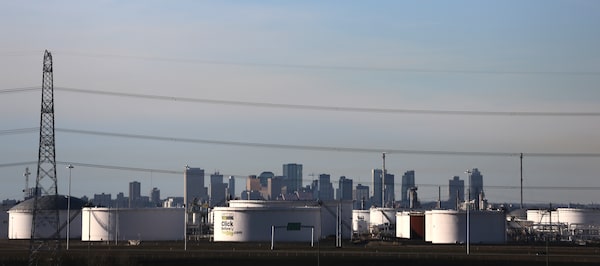
Crude oil storage tanks at an Enbridge facility are seen against the Edmonton skyline in November, 2016. Alberta's unemployment rate fell to 6.3 per cent in March, according to Statistics Canada’s labour force survey released on Friday.Chris Helgren/REUTERS
Alberta’s jobless rate has sunk to its lowest level in nearly three years, another sign that the oil-producing province is recovering from the energy slump.
The unemployment rate fell to 6.3 per cent in March from 6.7 per cent in the previous month, according to Statistics Canada’s labour force survey released on Friday. That is the province’s lowest level since the summer of 2015, when employers were slashing jobs in response to the drop in oil prices.
“It continues a very strong trend that we have seen for quite some time now,” said Trevor Tombe, associate professor of economics with the University of Calgary.
The rate has been steadily falling since it peaked at 9 per cent in 2016. As crude prices have steadied, energy producers and the swath of businesses that support the oil patch have been hiring.
The province has gained 46,500 full time jobs over March of last year, with new positions in natural resources, construction, finance and educational services.
“Some of the recovery is not that oil prices have recovered, but there is more certainty about what the floor is,” Mr. Tombe said. “For a while, in the beginning of the recession, it was unclear how low it would go.”
The province’s employers are also increasing pay, in addition to mandatory minimum wage hikes. Since last summer, the average hourly wage has expanded by at least 2.8 per cent. The 12 months to March showed wages up 2.9 per cent to $30.75 an hour.
“There is little doubt that Alberta has turned the corner in a meaningful way,” said Douglas Porter, chief economist with Bank of Montreal .
Pay levels in Alberta, which were responsible for boosting the national average during the oil boom, helped contribute to the country’s recent pickup in wages.
For the third consecutive period, wage growth in Canada was above 3 per cent. The country’s average hourly wage rose 3.25 per cent to $26.97 over March of last year. But it’s not just Alberta’s performance. Earnings in B.C. and Ontario are increasing. B.C. ‘s hourly average jumped 5.6 per cent and Ontario’s was up 3.8 per cent over the same period.
The Bank of Canada is closely watching wage inflation. The central bank left the benchmark interest rate at 1.25 per cent at its scheduled March interest rate announcement, and said “wage growth has firmed, but remains lower than would be typical in an economy with no labour market slack” (that is, no one left to hire).
“It will be one of the fundamental reasons why they are likely to be lifting rates later this year,” Mr. Porter said. “They don’t want to crush wages, but the view is that things are healthy enough in the labour market … that interest rates should return to normal.”
Some of Ontario’s wage growth likely stems from the higher minimum wage, which jumped by $2.40 to $14 an hour in January.
Economists said it was still too early to see fallout from the higher minimum wage. Industries dominated by low-paid positions have both added and cut jobs.
In Ontario, accommodation and food services created 7,200 new positions in the first three months of the year. Meanwhile, wholesale and retail eliminated 23,900 jobs over the first quarter.
Over all, 32,300 jobs were created in the country last month, with full time gains offsetting part-time cuts. The jobless rate remained at 5.8 per cent, a level first touched in December. Before that, the last time the country hit that rate was in October, 2007.
“Employment is on a strong, steady upward trend,” said Andrew Fields, analyst with Statscan. “So much so that we’re taking it for granted now.”
 Rachelle Younglai
Rachelle Younglai